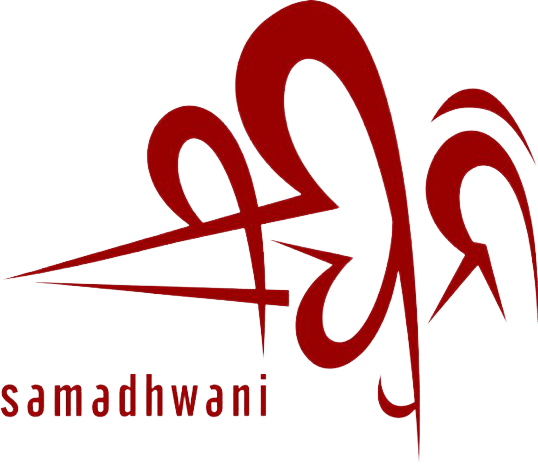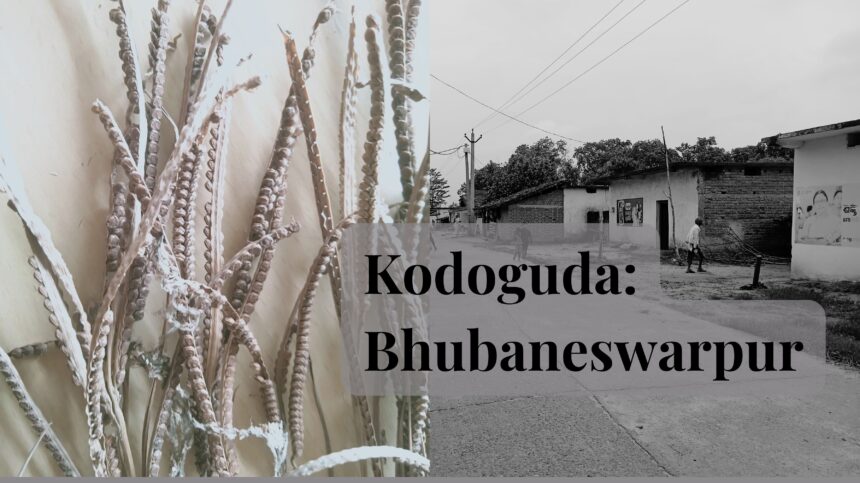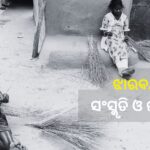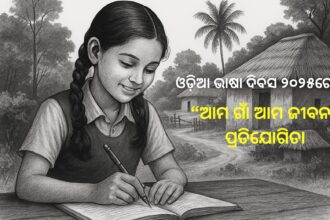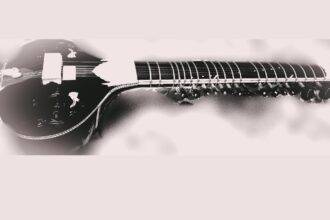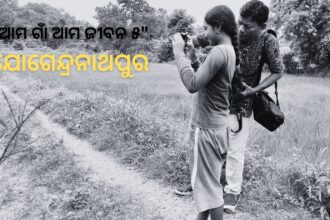In 2023, when Lopamudra Pradhan was studying in Class IX at Bhubaneswarpura High School, she showed interest in researching about her own village. Her mother’s name is Premshila Pradhan and her father’s name is Loknath Pradhan. The name of her village is Bhubaneswarpura, which was earlier known as Kudoguda. While documenting the history and culture of her village, Lopamudra explored how the name of her village changed from Kudoguda to Bhubaneswarpura and the cultural journey behind it. She sat with the elderly people of the village and with her grandfather, listening to stories from the past and old memories. In the summer of 2025, she completed her documentation work on her village. Through this journey, she also became a member of the Village Biographers Community – Editor
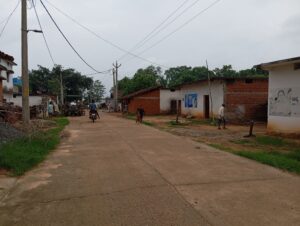
My Feelings While Writing the History of My Village – Lopamudra Pradhan
The very first time Swayamprava madam came to our school and told us, “You all will write the history of your village,” something clicked inside me. I felt a strong wish to know how my village got its name and what it was like in the past. When I went home and shared this with my parents, they were so happy. They encouraged me, saying, “Write it down, and through that, you will know the history of your village.” After that, I started going to different people in our village, especially the elders, and asked them about it. They were also very happy. With so much interest, they explained everything to me, from the very first settlement in our village to the present day.
I talked to many people: Nandalala Sahu (85), Dirju Rana (72), Dinamani Hati (78), Nilakantha Satnami (37), Suresh Rana (49), and Asha Karmi (50). My grandfather, Madhab Sahu (73), especially helped me a lot. I realized that writing the history of a village is not a small thing; it is a very big step. Very few people get the chance to collect this kind of knowledge. While I was talking to the elders, I noticed one thing: this was not only my work. It was also their responsibility. The love they had for their village was something beyond imagination. Through this writing, the people of our village will get to know about their own roots. In that happiness, they helped me with so much excitement and interest. Even I got to learn so many new things after finishing my writing.
I started this work after my Class 10 exams, and throughout the 2025 summer holidays, I stayed connected with it. Now, I have decided to continue this work in the future too. That is why I have also become a member of the Village Biographers Community.
About Lopamudra Pradhan
Lopamudra Pradhan, a student from Bhubaneswarpura village, Paikmal block, Bargarh district, has shown remarkable dedication in documenting the history and culture of her community. Through careful collection of oral narratives from elders and her own observations, she has written about the traditions, livelihoods, and social practices of her village with sincerity and depth. Her article and poem published in Samadhwani highlight the beauty of Bhubaneswarpura’s heritage, from its environment and festivals to its unique traditions of cooperation. Lopamudra’s work reflects how young students can meaningfully contribute to preserving village history under the Ama Gaan Ama Jiban initiative, inspiring others to value and protect their cultural roots.
The Past of Bhubaneswarpur
Our village is called Bhubaneswarpur. It is about 12 km away from Paikmal, through Koknara and Chetgaan villages. But long ago, our village was not known by this name. It was first called Kudoguda. Since the whole area was covered with thick forests, kudo (a kind of millet) used to grow very well here. That is how it got its first name. The elders told me that the village was established around the year 1700.
I came to know that eight families of potters (kumbharas) came from Khemda village. They cleared the forest and made their homes in what is now known as Kumbhar Pada. They were the first people to settle here. Along with them, some families from the Binjhal, Sahara, Kolha, Harijan, and Chamar communities also came. Later, a man named Shobharam Rana became the Gauntia (the head of the village).
Around 1907- 08, during the time of land settlement, the Dewan of Padmapur Zamindar came to our village. His name was Bhubaneswar. He wanted the village to be named after him. From that time, our village started being called Bhubaneswarpur. The Gauntia then paid 1,000 rupees to the Zamindar and got the Gauntia Patta for about 300 acres of land. But later, for some reason, there was a quarrel between the Dewan and the Zamindar. The Zamindar took back the Patta, saying he would rewrite it properly, but he never returned it. During that period, the Gauntia had dug a big pond in the village, which still remains. After some years, the Zamindar wanted to turn Kudoguda into his own estate land. So, he brought Teli families from Mahulpali and settled them here. Later, the Gauntia Patta was given to the Teli community. From then onwards, the Telis became the Gauntias of our village.
I noted down the names of some of them: Ram Das Sahu, Sankirtan Sahu, Nityananda Sahu, Gour Sahu, Panchanan Sahu, and Bhojaraj Sahu. After that, many more families of the Teli community came here to live. Slowly, people from Gauda, Brahmin, Bhandari, Kuli, Harijan, and other communities also came and made this place their home. That is how our village became bigger and more diverse.
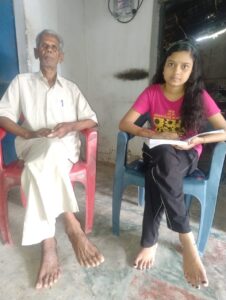
The Present
The population of our village is about 4,000. There are nearly 750 houses here, most of them well-built, and some are partly concrete houses. People from many communities live in our village: Kumbhar, Binjhal, Sahara, Teli, Gauda, Kol, Kuli, Bhandari, Brahmin, Mali, Harijan, and Chamar.
Different kinds of traditional work are still practiced here, like carpentry, pottery, blacksmithing, and weaving. One villager, Shesadev Sahu, who works as a carpenter, has even been awarded at the district level for his skills.
On the north-west side of the village, there is a small perennial spring called Kuten Chua flowing over a big rock. Water remains there throughout the year. Nearby, there are four huge stones locally known as Bhima Paha and Bhima Bati.
The village has a primary school, an upper primary school, and a high school. About 170 students study in the primary school, 150 in the upper primary, and 130 in the high school. In the past, our village faced a severe shortage of water. People had to walk 4 km to fetch it. But now, there are tube wells in the village.
The respected elders of the village organize meetings several times a year to discuss matters related to the well-being of the village. Apart from that, each community also has its own caste-based association to resolve internal issues.
There is also a beautiful tradition in our village. During marriages or purification rituals, relatives and neighbors contribute money and materials so that the family can perform the ceremony without any difficulty, even if they don’t have enough resources. For weddings, people contribute everything-from rice to other essential items. For funerals, relatives take the responsibility of covering the food expenses.
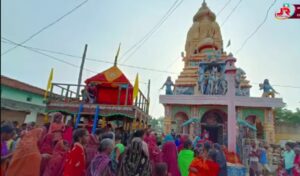
Festivals and Food of Our Village
In our village, there are temples dedicated to Lord Jagannath, Lord Shiva, and Goddess Lakshmi. Therefore, festivals like Rath Yatra, Jagar, and Manabasa are celebrated here. On Paush Purnima, the Chher Chhera festival takes place. Every household prepares traditional items like Arisa Pitha, Kakara Pitha, Biri Bara, Mug Bara, and Wheat Bara. Apart from these, people also make pakodi, singada, aluchop, nali, pampad from flour and gram flour. There is a tradition of sharing these foods with neighbors.
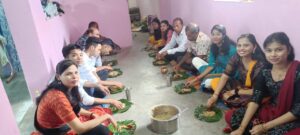
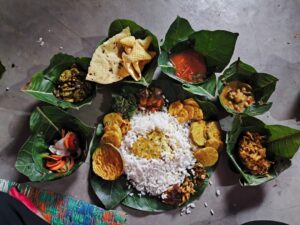
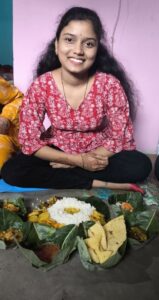
Nuakhai Celebrations
During Nuakhai festival, offerings like khiri, puri, mugbara, arua rice, jhalli, and vegetables are cooked for the deities, often accompanied by a ritual hen sacrifice. On Shravana Amavasya, the Harali festival is celebrated with rituals for ploughs and bullocks, where they are fed rice, Dal, and khiri. The village deities at the Donguri shrine-Thakur Debata, Budharaja, Bhat Parshi, and Chetgen Mauli—are worshipped during Harali, Nabanna, Kado Yatra, and Maden Yatra. At Bada Dangar, the Siddha Baba is worshipped. On Bhadrab Amavasya, the Satbahani or Kantagusien puja is held at the village pond.
In earlier times, food was much simpler. At weddings, people offered chuda, gur, lia, and curd for snacks, while the feast included rice, Dal, meat curry, jukha, and arisa pitha. The arisa pitha is a famous delicacy of Western Odisha. In Bhadra month, the first harvest of paddy is celebrated with joy, marking Nabanna as an agriculture-based festival. On Nuakhai day, the new crop is first offered to the village deity before being used in household worship. Food and drink are prepared in abundance; families eat together, and younger members bow to elders after the meal. The evening is filled with merrymaking, visiting, and exchanging food. The village also has kirtan groups, women’s kirtan groups, and women’s danda nrutya groups. During festivals, women wear Sambalpuri sarees, while men wear dhoti and dhila.
During Rath Yatra, nearly every household prepares festive foods such as arisa, biribara, sweets, mugbara, and pakodi. Earlier, special items like baragulia, haldi ganthi, and pagla bara made from jaggery and rice were common, though these are no longer prepared. These days, in the mornings, most families have tea with chakuli pitha, and tea with puffed rice (mudhi) is a daily staple. At lunch, people eat rice, Dal, leafy vegetables, fish, meat, and curry, while dinner usually includes rice, roti, and Dal.
In the past, people ate mandia tikiri, kodo tikiri, wild mushrooms, mahul flowers, fena saag, karadi, and hendua, with jaggery widely used. Today, however, food is more oil- and spice-heavy. Yet, millets like mandia(Ragi) and kodo are being cultivated and eaten again. Our mothers are skilled in preparing traditional items like suali pitha, arisa pitha, and manda. They make jatani by mixing rice flour with jaggery and deep-frying it in oil. Arisa pitha can be stored for a long time. Nowadays, younger women use semolina instead of rice flour to prepare such dishes. Using refined flour, semolina, gram flour, and wheat flour, they make manda, suali, laddoo, gaja, and kalsei.
In recent times, health issues like indigestion, diabetes, high blood pressure, weak eyesight, and fevers have become more common, leading villagers to visit hospitals for treatment. The village has both an Ayurvedic health centre and a clinic. Earlier, epidemics like smallpox and cholera were frequent, but these no longer occur.
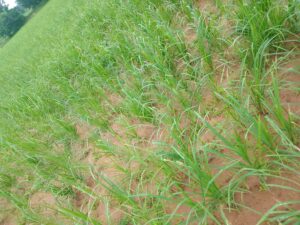
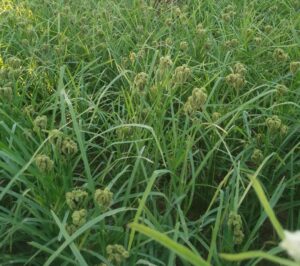
Farming and Food Habits
In our village people grow paddy, green gram, black gram, ragi, bajra, maize, and vegetables. Among them, paddy is grown the most. The village has about 2,000 acres of farmland, apart from a lot of forest land that is not suitable for cultivation. Farmers mostly depend on rainwater for farming. Around 20 farmers have dug deep tube wells and they grow crops in both seasons. Almost 400 villagers go outside the state to earn their livelihood. They go to Tamil Nadu, Gujarat, Karnataka, and Uttar Pradesh to work as brick makers, carpenters, or in thread mills.
Nowadays there is more land for paddy farming, but in earlier times it was not like this. Most of the land used to be dry upland. So, rice production was less in those days, and people often faced a shortage of rice. On those uplands, people grew crops like kodo, ragi, gurji, green gram, black gram, groundnut, kolath, harad, and raxi (a type of bajra). Gurji pitha was a popular snack, and many families used to eat kodo rice. To manage the shortage of rice, people also ate boiled mahua flowers, puffed mahua seeds, and other forest foods. Sugarcane was grown too, and people used to prepare jaggery. On small plots they grew tubers, which they roasted or boiled and ate as snacks. Stale rice water (basi pakhala) was one of the most loved foods.
But now, those foods are no longer there. People mostly eat rice cakes made with black gram, or they eat suji, puffed rice, and tea as breakfast. Rice and chapati have become the main food. People eat more fish and broiler chicken these days. Earlier, people drank handia (country liquor) along with milk, pitha, puffed rice, and jaggery. They lived long and healthy lives. But now, even though liquor is still consumed, people don’t take healthy food with it. Drinking has increased beyond limits. In the past, drinking was limited and kept the body strong, but not anymore.
Food habits of the villagers have changed a lot compared to the past. The crops that people once grew are now almost lost. Gurji, ragi, kodo, and tubers are hardly seen today. Basi pakhala was once very common, but now it is also disappearing. Because of the absence of those foods, villagers are not as healthy as before. Boiled mahua flowers once worked like medicine for digestion, but now it is gone too. Nowadays, people focus more on paddy cultivation. Cotton is also grown as a cash crop. Groundnut, green gram, black gram, maize, and ragi are no longer grown in large amounts.
The Village Environment
All around our village there are hilly areas. Because of the many trees and plants, it is believed that rainfall is quite good here. The forests are of deciduous type. In them grow trees like teak, sena, mahua, char, neem, sal, piyasal, belua, harida, and bamboo. From the mahua trees, people collect flowers and can manage their lives comfortably. They also collect char seeds, kendu leaves, harida, and chakda seeds and earn some money by selling them.
Earlier, there used to be many bherun and mahanim trees in the village, but now they are gone. Still, the village environment is safe. Since animals like wild boar and bear live in the forest, people do not destroy it much. There is plenty of grazing land in the village, but still villagers don’t keep many cattle. Mostly they raise goats in large numbers. In our forest one can see birds like myna and lua. People cut trees for fuel and house construction. Oxen are used for farming. Goats, sheep, and chickens are kept for meat.
Among all trees, mahua is given special importance. From it come mahua flowers and tol fruit, which people depend on for their living. Even if they face hardship, they never cut the mahua tree. Liquor made from mahua is a kind of intoxication. Without this drink, song and dance do not take place. That is why during Karma Puja, mahua liquor is used. People believe that drinking it and worshiping Karamshani brings them blessings of the four goals of life.
In our village, many animals and birds like sparrows, mynas, eagles, parrots, wild pigs, cranes, and wild cats are now almost extinct. Earlier, sparrows lived happily in thatched houses, but now they are gone. Once there were plenty of these creatures, but because of deforestation, wild pigs and cranes are no more. Without wild insects, the Saguna bird has also disappeared. Due to the use of pesticides, many animals and birds are vanishing. People no longer respect trees like banyan, pipal, pankel, dimiri, and jamukoli. The environment is no longer as friendly to animals and birds as before.
Still, the forest near our village helps us to remain healthy. We get fresh air to breathe. People collect mahua and tol fruits from the forest, sell them, and live well. They also earn some money by selling char seeds, kendu leaves, harida, chakda seeds, tamarind, bahada, amla, and karadi. Villagers know about triphala churna. Our local vaidya says that Ayurvedic medicines can cure diseases completely.
Even though the population of the village is increasing, the environment here has not changed much. People live almost like before. The forest guards live nearby, so there is no problem in protecting the forest. On the government’s side, work like planting trees and digging trenches around the forest is going on properly. People of the village are united for forest protection.
On the north-western side of the village, at the foothills of Kuten Hill, there is a big rock with a perennial spring called Kuten Chua, along with Bhima Bati and Bhima Paha. The spring is narrow but very deep, and it holds water throughout the year. It should become a tourist place. Day by day, we can see that our village is moving towards development.
Problems and Solutions
For the development of our village, the respected elders organize meetings at different times. Besides that, every community has its own organization. They solve problems related to their caste through these groups. During marriage and purification ceremonies, one remarkable tradition can be seen here. At the time of marriage, relatives and neighbours extend such financial help that even if the family has no money, the wedding still takes place smoothly. People contribute rice, pulses, oil, sugar, fish, meat, and even brass utensils as donations. The same kind of help is given during purification rituals as well.
In our village, a weekly market is held every Wednesday. People bring vegetables and sell them. Paddy, mahua flowers, tol fruits, char seeds, harida, and chakda seeds are sold to local traders. But for buying marriage items, people still have to travel to faraway places. About 200 people in the village are engaged in different types of small businesses. From the weekly market, villagers buy clothes, fancy items, groceries, brass utensils, and iron materials. Since mahua and tol are available in plenty here, outside traders come and purchase them in bulk. Still, this does not create any problem for the local traders.
I have collected all this information from the elders of my village, especially from my grandfather, Madhab Sahu, who is 75 years old. I have also gathered one story from our village’s past.
The Healer (A Story from the Past)
The name of our village is Bhubaneshwarpur. Earlier, it was called Kudoguda. Even before that, this place was covered with forests, hills, and mountains. During the dry season, a few potter families from Khemda village would come here slowly, one by one. The fragrance of Kurei flowers delighted their hearts. They knew that the bark of this tree was a medicine for women’s monthly cycles. Besides this, many other medicinal plants caught their attention. They also saw Rengal trees with Rengal fruits lying beneath them. The char, kendu, veluan, mango, jamukoli, date palm, dimiri, ala, harida, and bahada trees were full of fruits. They ate these fruits to fill their stomachs and then noticed a small well on a flat rock, which had water. This well is what we now call the Kuten Chua. Drinking this water, they felt some special blessing of the place. They loved the environment of this area very much. On their way back home, they decided to build houses and settle here.
Later, eight families came to this place, cleared the forest, and established their settlement. They reared cows and calves in large numbers and also kept goats and sheep. They cultivated paddy along with kod and mandia crops. They stored mahua and other dried fruits carefully. They stayed alert against wild animals. Their daily food included kod bhat, mahua shoots, mandia porridge, and dried fruits. They had enough ghee, sesame, curd, butter, milk, mahua, and rice cakes. They were strong, healthy, and long-lived. They knew the medicinal qualities of the trees. Many times, they collected bark and fruits of kau (Arjuna), neem, mahanim, mango, jamukoli, mahua, and other plants, boiled them, and drank the decoction. It purified the blood, cured heart disease, and helped digestion. Ghee and mahua were excellent remedies for fever. They often ate rice cakes, arisa, kakra, manda, and bara. They cooked mung beans with jaggery and oil, which was called dudhura, a dish that no longer exists today. Their daily food can now be compared to modern vitamins. The past era was called the era of ghee and mahua. There was a method for consuming ghee and mahua to stay healthy. Mahua was also used to reduce obesity. Good health was impossible without ghee and mahua. Ghee and mahua were considered equivalent to doctors and were called the “village physician” of the past.
I realized that writing the history of a village means bringing its fame, reputation, customs, traditions, and culture to the eyes of people. By spreading this knowledge, the village’s dignity increases. Visiting various families and interacting with them has also changed my own behaviour. I learned how to gather the necessary information from people and how to present examples properly. At the same time, I felt a path for my own future. Writing this made me very happy. I learned many things about my village that I did not know before, and I felt very joyful hearing the new stories. I was very happy to know how our village got its name. I sincerely thank Swayamprava Mam for starting this work, and I pray to God for her success in this project.
My Village
Bhubaneshwarpur, that’s its name
Where the soil glows with beauty’s flame.
Surrounded by hills, my village lies,
With trees of many kinds that rise.
Mahua trees nurture life each day,
Here, no scarcity comes our way.
Village elders, with care and love,
Hold meetings guided from above.
Every person shares in the gain,
Great welfare for all to attain.
Like a family, the village thrives,
Its environment sustains our lives.
From faraway lands, people come here,
To settle in peace, year after year.
In weddings and sacred rites,
Help and support reach wondrous heights.
Even if the host lacks a dime,
The work begins right on time.
Banyan trees and bears provide a place,
Snakes coil in silence, leaving no trace.
Fearless of wild creatures’ might,
We pass our days in calm delight.
